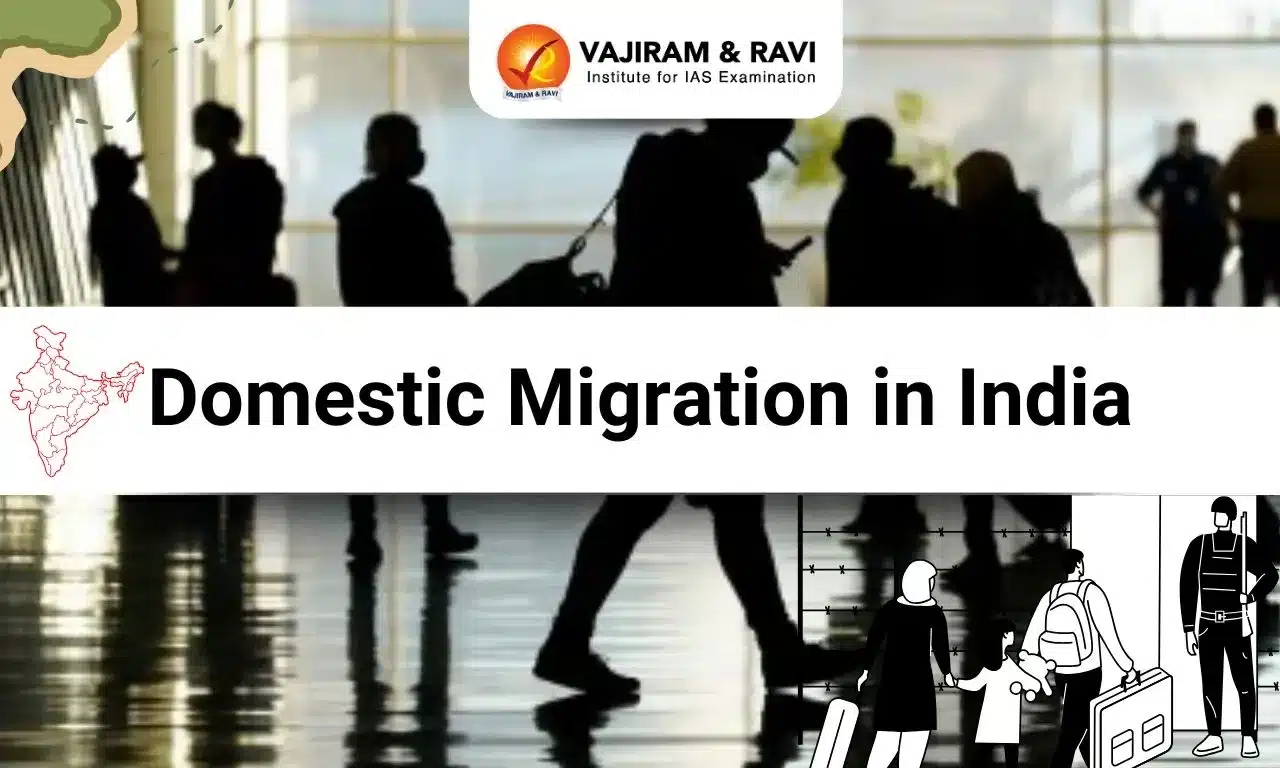What’s in today’s article?
- Why in News?
- What is Migration?
- Methodology Used by the EAC-PM for Finding Domestic Migration in India
- Key Findings EAC-PM Paper on Domestic Migration in India
- Challenges in Migration Data
- Conclusion
Why in News?
- Domestic migration in India has witnessed a significant slowdown, with the total number of migrants declining by 11.78% from 2011 to 2023.
- A recent working paper by the Economic Advisory Council to the Prime Minister (EAC-PM), titled “400 Million Dreams!”, highlights key trends, reasons for the decline, and changes in migration patterns.
What is Migration?
- Meaning:
- Migration is the movement of people away from their usual place of residence, either internal (within the country) or international (across countries) borders.
- The migration arising out of various social, economic, or political reasons helps in understanding the dynamics of the society better.
- Various forms and patterns of migration:
- Internal migration (rural-urban, intra-state, inter-state, etc) refers to migration from one place to another within a country, while external migration or international migration refers to migration from one country to another.
- Forced migration refers to migration that is not chosen by the individual or family but is forced upon them by factors such as war, persecution, or natural disasters.
- Voluntary migration refers to migration that is chosen by the individual or family, driven by factors such as better economic opportunities or a desire for a better life.
- Temporary migration refers to migration that is intended to be of short duration, such as seasonal or temporary work.
- Permanent migration refers to migration that is intended to be of long duration, intending to settle permanently in a new place.
- Reverse migration refers to the migration of individuals or families (who have previously migrated), back to their country of origin or their original place of residence.
Methodology Used by the EAC-PM for Finding Domestic Migration in India:
- The report used 3 datasets to estimate migration trends:
- Indian Railway Unreserved Ticketing System (UTS) for passenger volumes.
- TRAI mobile roaming data to study seasonal movement.
- District-level banking data for remittances.
- These alternative sources were employed due to delays in the decennial Census, which is a more comprehensive but less timely data source.
Key Findings EAC-PM Paper on Domestic Migration in India:

- Decline in migration numbers:
- Overall reduction: The number of migrants reduced from 45.57 crore (2011 Census) to 40.20 crore (2023).
- Migration rate: The migration rate dropped from 37.64% in 2011 to 28.88% in 2023.
- Improved economic opportunities:
- Migration is slowing due to better economic opportunities in smaller cities, improved infrastructure, and access to education and healthcare near traditional migration hubs.
- This shift indicates overall economic growth in source regions.
- Recipient states:
- Top recipient states: UP, Maharashtra, and Madhya Pradesh remain prominent, while West Bengal and Rajasthan are new entrants, replacing Andhra Pradesh and Bihar.
- Growth patterns: States like West Bengal, Rajasthan, and Karnataka showed the highest growth in migrant arrivals, whereas Maharashtra and Andhra Pradesh experienced a decline.
- Regional migration trends:
- Top origin districts: Areas around major urban centers like Delhi, Mumbai, Chennai, Bangalore, and Kolkata remain prominent sources.
- Top destination districts: Mumbai, Bengaluru urban, Howrah, Central Delhi, and Hyderabad are key destinations.
- Seasonality of migration:
- Peak migration movements occur during April-June, with secondary peaks in November-December.
- Post-pandemic data shows reduced passenger movement during these high months, with May 2023 levels 6.67% lower than May 2012.
Challenges in Migration Data:
- The lack of regular and granular data poses challenges in understanding migration patterns.
- Existing reports, such as the MoSPI Migration in India 2020-21 and the Ministry of Housing and Urban Poverty Alleviation (MoHUPA) Working Group Report on Migration (2017), highlight limitations in tracking trends effectively.
Conclusion:
- The slowdown in domestic migration reflects economic growth and regional development but underscores the need for improved data collection mechanisms.
- Accurate and timely data is crucial for policy formulation to address migration-related challenges and opportunities effectively.
Q.1. What is the One Nation One Ration Card (ONORC) scheme?
ONORC is a scheme that allows ration card holders to access their food grains from any Fair Price Shop (FPS) in the country. The scheme was launched in 2018 by the Ministry of Consumer Affairs, Food & Public Distribution to benefit the migrant population in India.
Q.2. What is the Son of the Soil doctrine?
The Son of the Soil doctrine is a political strategy that talks about the rights of the local people over their land, culture, and resources available in their region.
Source: IE
Last updated on June, 2025
→ UPSC Notification 2025 was released on 22nd January 2025.
→ UPSC Prelims Result 2025 is out now for the CSE held on 25 May 2025.
→ UPSC Prelims Question Paper 2025 and Unofficial Prelims Answer Key 2025 are available now.
→ UPSC Calendar 2026 is released on 15th May, 2025.
→ The UPSC Vacancy 2025 were released 1129, out of which 979 were for UPSC CSE and remaining 150 are for UPSC IFoS.
→ UPSC Mains 2025 will be conducted on 22nd August 2025.
→ UPSC Prelims 2026 will be conducted on 24th May, 2026 & UPSC Mains 2026 will be conducted on 21st August 2026.
→ The UPSC Selection Process is of 3 stages-Prelims, Mains and Interview.
→ UPSC Result 2024 is released with latest UPSC Marksheet 2024. Check Now!
→ UPSC Toppers List 2024 is released now. Shakti Dubey is UPSC AIR 1 2024 Topper.
→ Also check Best IAS Coaching in Delhi
























